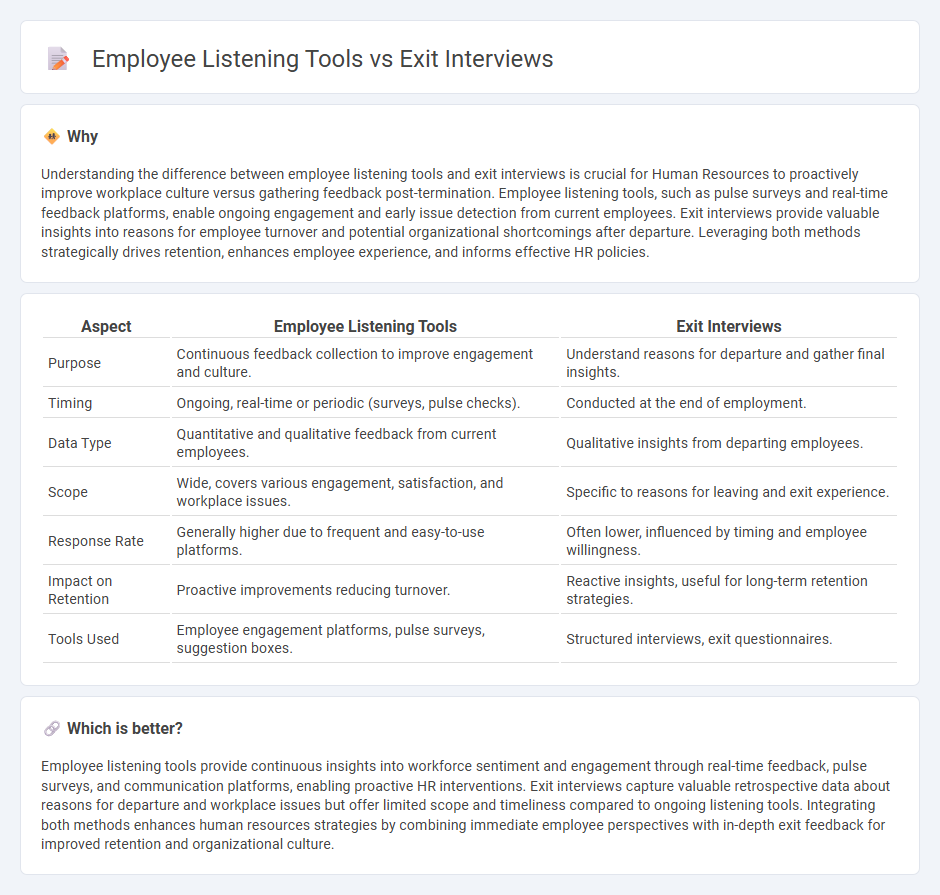
Employee listening tools capture real-time feedback and sentiment through surveys, pulse checks, and engagement platforms, offering ongoing insights into workforce morale and productivity. Exit interviews collect retrospective data from departing employees to identify reasons for turnover and areas needing improvement. Explore how integrating these approaches can enhance talent retention and organizational culture.
Why it is important
Understanding the difference between employee listening tools and exit interviews is crucial for Human Resources to proactively improve workplace culture versus gathering feedback post-termination. Employee listening tools, such as pulse surveys and real-time feedback platforms, enable ongoing engagement and early issue detection from current employees. Exit interviews provide valuable insights into reasons for employee turnover and potential organizational shortcomings after departure. Leveraging both methods strategically drives retention, enhances employee experience, and informs effective HR policies.
Comparison Table
| Aspect | Employee Listening Tools | Exit Interviews |
|---|---|---|
| Purpose | Continuous feedback collection to improve engagement and culture. | Understand reasons for departure and gather final insights. |
| Timing | Ongoing, real-time or periodic (surveys, pulse checks). | Conducted at the end of employment. |
| Data Type | Quantitative and qualitative feedback from current employees. | Qualitative insights from departing employees. |
| Scope | Wide, covers various engagement, satisfaction, and workplace issues. | Specific to reasons for leaving and exit experience. |
| Response Rate | Generally higher due to frequent and easy-to-use platforms. | Often lower, influenced by timing and employee willingness. |
| Impact on Retention | Proactive improvements reducing turnover. | Reactive insights, useful for long-term retention strategies. |
| Tools Used | Employee engagement platforms, pulse surveys, suggestion boxes. | Structured interviews, exit questionnaires. |
Which is better?
Employee listening tools provide continuous insights into workforce sentiment and engagement through real-time feedback, pulse surveys, and communication platforms, enabling proactive HR interventions. Exit interviews capture valuable retrospective data about reasons for departure and workplace issues but offer limited scope and timeliness compared to ongoing listening tools. Integrating both methods enhances human resources strategies by combining immediate employee perspectives with in-depth exit feedback for improved retention and organizational culture.
Connection
Employee listening tools gather real-time feedback and insights on workplace satisfaction, engagement, and concerns, enabling proactive management of employee experience. Exit interviews complement these tools by providing detailed explanations for turnover, revealing trends and root causes behind departures. Together, they offer a comprehensive understanding of workforce sentiment, helping Human Resources optimize retention strategies and improve organizational culture.
Key Terms
Feedback
Exit interviews offer structured feedback from departing employees, capturing insights about their experiences and reasons for leaving. Employee listening tools gather real-time, continuous feedback from current staff through surveys, pulse checks, and sentiment analysis to enhance engagement and retention strategies. Explore how combining both methods delivers a comprehensive approach to organizational feedback management.
Retention
Exit interviews provide valuable insights into why employees leave, highlighting areas needing improvement to boost retention. Employee listening tools gather real-time feedback, enabling organizations to address concerns proactively and foster engagement. Explore how integrating both approaches can enhance employee retention strategies effectively.
Engagement
Exit interviews provide valuable insights into employee turnover reasons by capturing feedback at the end of employment, while employee listening tools continuously gather real-time data to monitor engagement levels and workplace sentiment. Engagement-focused listening tools utilize surveys, pulse checks, and sentiment analysis to identify issues early, enabling proactive retention strategies and a more dynamic understanding of workforce morale. Explore comprehensive solutions to enhance employee engagement and reduce attrition effectively.
Source and External Links
Effective Exit Interviews: Strategies & Tips - BambooHR - An exit interview is a discussion between a departing employee and their organization, typically held on the last day of work, to exchange feedback and reasons for leaving, and is not legally required unless specified in an employment contract.
Exit interview: What is it and the questions to expect - Personio - Exit interviews are final conversations with departing employees, best conducted one-on-one in a neutral setting by HR, to gather honest insights on the employee's experience and areas for organizational improvement.
12 Exit Interview Question Examples (With Tips) | Indeed.com - Exit interviews provide employers with an opportunity to understand why employees are leaving, gather feedback on workplace culture and management, and identify ways to reduce turnover and improve the employee experience.
 dowidth.com
dowidth.com